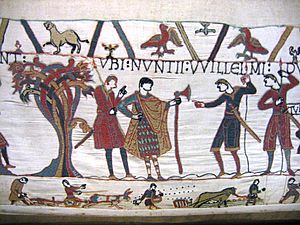Dane axe facts for kids
The Dane axe was a special type of battle axe used a long time ago. It was popular during the time of the Viking Age and the early Middle Ages in Europe. People also called it the English long axe or Danish axe.
How the Dane Axe Was Made
Most Dane axes had a wide, thin blade. It often had pointy parts, like "horns," at the top and bottom of the cutting edge. The cutting part was usually about 20 to 30 centimeters (8 to 12 inches) long.
The blade itself was quite light and very thin. This made it excellent for cutting things. It was often as thin as 2 millimeters (0.08 inches) near the edge. Many of these axes had a stronger, harder steel at the very edge. This made the axe sharper and tougher. An average Dane axe weighed between 1 and 2 kilograms (2.2 to 4.4 pounds). It was more like a modern meat cleaver than a wood-chopping axe. This special way of making it created a fast and powerful weapon.
The handle, or haft, of a combat Dane axe was usually about 0.9 to 1.2 meters (3 to 4 feet) long. Some axes, used as symbols of power, could be even longer, up to 1.7 meters (5.5 feet). These special axes sometimes had silver designs and were not as sharp as war axes. Some old axes also have a decorated brass cap on the end of the handle. This cap likely helped keep the axe head secure and protected the handle. The handles were probably made from strong wood like ash or oak.
History of the Dane Axe

From the 800s to the 1000s, the Dane axe became popular outside of Scandinavia. This happened because of Viking trade or their influence. It also developed on its own in places like England, Ireland, and Normandy.
Important fighters of this time, like the Huscarls in Anglo-Saxon England, often used the Dane axe. The Bayeux Tapestry shows the story of William the Conqueror becoming king of England. In it, the axe is mostly carried by the well-armored Huscarls. These Huscarls were the main bodyguards for King Harold at the Battle of Hastings. The tapestry even shows a Huscarl chopping off a Norman knight's horse's head with one swing!
The Dane axe was also used by the Varangian Guard. This was a group of elite soldiers who protected the Byzantine Emperor. They were even called the "axe-bearing guard." An old carving from the 900s shows a Varangian holding an axe as tall as himself.
By the 10th century, the Dane axe was used widely across Europe. Axes even became accepted as a weapon for knights, though not as highly as swords. They also became common for foot soldiers, with longer handles of about 1.8 meters (6 feet). In the 1200s and 1300s, the axe changed again. The blade became longer, and the "horn" at the back often reached or attached to the handle. This longer weapon was called a sparth in England. Some people think this weapon was the ancestor of the halberd.
The Dane axe was still used into the 1300s. However, axes with a spike on the back for piercing armor became more common. These later evolved into the pollaxe in the 1400s. The simple Dane axe was still used in parts of Scotland and Ireland into the 1500s. In Ireland, it was especially linked to gallowglass mercenaries.
Famous People Who Used the Axe
After the Battle of Stiklestad, the axe became a symbol for St. Olaf. You can still see it on the Coat of Arms of Norway. This is because he was killed with an axe, not because he used one in battle.
The Anglo-Saxon Chronicle tells a story about a huge Norse axeman. He likely used a Dane axe at the Battle of Stamford Bridge. He supposedly killed up to 40 Englishmen by himself! He was only defeated when an English soldier floated under a bridge in a barrel. The soldier then stabbed him from below with a spear.
King Stephen of England famously used a Danish axe at the Battle of Lincoln in 1141. One story says he used it after his sword broke. Another says he used his sword only after his axe broke.
Richard the Lionheart was often shown in old stories using a large war axe. These stories sometimes made his axe seem even bigger than it was. For example, writer Charles Dickens described it as having "twenty English pounds of English steel." Richard is recorded using a Danish Axe when he helped defend Jaffa. Geoffrey of Lusignan was another famous crusader known for using an axe.
Robert the Bruce, King of Scotland, famously killed Henry de Bohun at the Battle of Bannockburn. He did it with one powerful blow of his axe. The blow was so strong it split de Bohun's helmet and skull and broke the axe handle. However, pictures of his axe show it was a standard battle axe, not a Dane axe.
In the 1300s, the use of axes was often mentioned by the writer Froissart. King John II used one at the Battle of Poitiers in 1356. Sir James Douglas used one at the Battle of Otterburn in 1388. People from Brittany were known for using axes. Both Bertrand du Guesclin and Olivier de Clisson carried axes in battle. It's not always clear if these were Dane axes or early versions of the pollaxe.
See also
- Broadaxe
- Long-bearded axe
- Sparth
- Viking Age arms and armour
- Viking halberd



